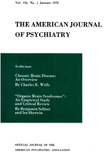RECENT TRENDS IN APHASIC RESEARCH
Abstract
This article is confined to a limited survey of contemporary literature and research on aphasia. An attempt has been made to correlate 3 different approaches to the subject in order to bring some unification to the problems involved.
These 3 approaches investigate the pathological phenomena of speech and language, labelled aphasia, from the anatomic-physiological, the psycho-mechanistic, and the structural- linguistic points of view.
Wiener's theory, which compares the human brain and nervous system to a highly complicated calculating machine or to a telephone switchboard service, was confirmed by Penfield and Rasmussen's anatomical findings on the operating table. Their findings refute the theory of previous authors that association areas utilize transcortical pathways. Penfield suggests that the mechanism responsible for the coordination of the speech centers is more probably mediated by subcortical projection pathways.
Penfield distinguishes between inborn and acquired connection patterns. With the exception of the temporal cortex, Penfield and his co-workers could not discover any positive evidence for acquired neuron connection patterns. In the temporal cortex only, electrical stimulation and epileptic discharge were able to bring to consciousness visual memories, auditory memories, and combined memories. They deduce, therefore, that "memory" is filed in the temporal cortex.
The linguistic-structural point of view is represented by the Dutch scientist Grewel. His observations in regard to aphasic patients whose linguistic faculties have suffered seem to indicate the presence of lesions in the temporal lobe of the dominant hemisphere. According to Penfield and Rasmussen it is there, as a result of a high level of neuronal integration, that memory patterns activating speech are formed.
The different phenomena of aphasic disturbances can best be explained by lesions in the dominant hemisphere that involve the destruction or disruption of acquired patterns of neuronal pathways. The symptoms may evidence injuries to acquired afferent and efferent synaptic chains of neuronal mechanisms.
Access content
To read the fulltext, please use one of the options below to sign in or purchase access.- Personal login
- Institutional Login
- Sign in via OpenAthens
- Register for access
-
Please login/register if you wish to pair your device and check access availability.
Not a subscriber?
PsychiatryOnline subscription options offer access to the DSM-5 library, books, journals, CME, and patient resources. This all-in-one virtual library provides psychiatrists and mental health professionals with key resources for diagnosis, treatment, research, and professional development.
Need more help? PsychiatryOnline Customer Service may be reached by emailing [email protected] or by calling 800-368-5777 (in the U.S.) or 703-907-7322 (outside the U.S.).



